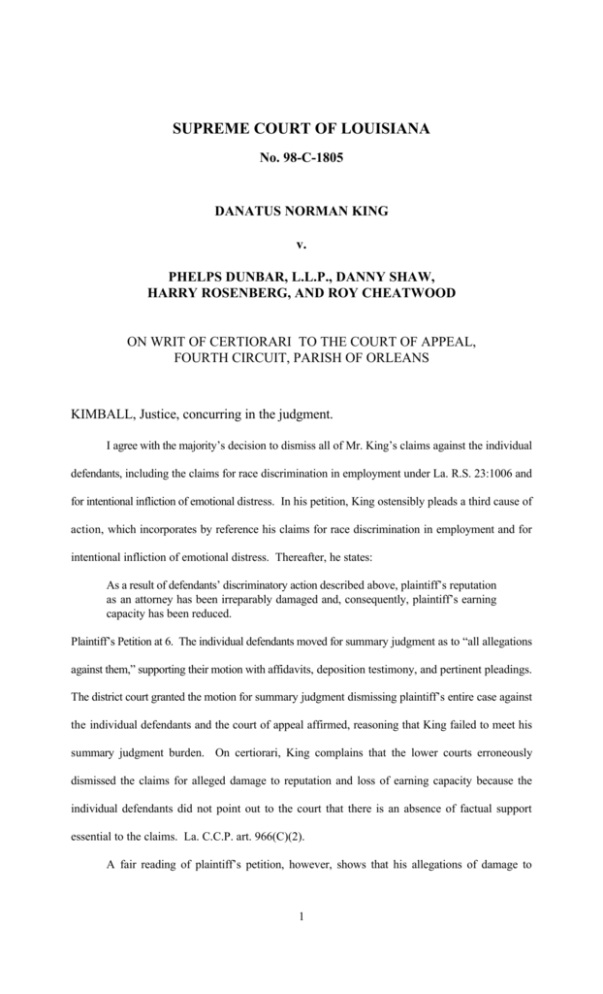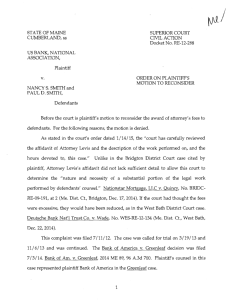KIMBALL, J. - concurs and assigns reasons.
advertisement

SUPREME COURT OF LOUISIANA No. 98-C-1805 DANATUS NORMAN KING v. PHELPS DUNBAR, L.L.P., DANNY SHAW, HARRY ROSENBERG, AND ROY CHEATWOOD ON WRIT OF CERTIORARI TO THE COURT OF APPEAL, FOURTH CIRCUIT, PARISH OF ORLEANS KIMBALL, Justice, concurring in the judgment. I agree with the majority’s decision to dismiss all of Mr. King’s claims against the individual defendants, including the claims for race discrimination in employment under La. R.S. 23:1006 and for intentional infliction of emotional distress. In his petition, King ostensibly pleads a third cause of action, which incorporates by reference his claims for race discrimination in employment and for intentional infliction of emotional distress. Thereafter, he states: As a result of defendants’ discriminatory action described above, plaintiff’s reputation as an attorney has been irreparably damaged and, consequently, plaintiff’s earning capacity has been reduced. Plaintiff’s Petition at 6. The individual defendants moved for summary judgment as to “all allegations against them,” supporting their motion with affidavits, deposition testimony, and pertinent pleadings. The district court granted the motion for summary judgment dismissing plaintiff’s entire case against the individual defendants and the court of appeal affirmed, reasoning that King failed to meet his summary judgment burden. On certiorari, King complains that the lower courts erroneously dismissed the claims for alleged damage to reputation and loss of earning capacity because the individual defendants did not point out to the court that there is an absence of factual support essential to the claims. La. C.C.P. art. 966(C)(2). A fair reading of plaintiff’s petition, however, shows that his allegations of damage to 1 reputation and loss of earning capacity are more fairly construed as elements of damage for the discrimination claims rather than as independent causes of action. “Every pleading shall be so construed as to do substantial justice.” La. C.C.P. art. 865. As such, the individual defendants’ motion for summary judgment, which sought and received a judgment dismissing all allegations against them, including the claim for race discrimination in employment, properly disposed of all claims against Messrs. Shaw, Cheatwood, and Rosenberg. I respectfully concur in the decision to reverse the judgment of the lower courts which sustained the exception of prescription as to all defendants. King’s discrimination claim essentially encompasses a claim for race discrimination in employment that includes the creation of a raciallyhostile work environment that ultimately forced him to resign. In determining whether plaintiff’s discrimination claims prescribed, the defendants suggest that we should avoid the “continuing violation” doctrine espoused in federal employment jurisprudence and recognized by this Court in Bustamento v. Tucker, 607 So. 2d 532, 541-42 (La. 1992), and instead incorporate the rule enunciated in Delaware State College v. Ricks, 449 U.S. 250, 101 S.Ct. 498, 66 L.Ed.2d 431 (1980), which holds that the date of notification of an adverse employment action begins the running of prescription. Considering the basis for applying the continuing violation doctrine in the employment context, and after evaluating the record evidence as it currently exists, I agree that King’s discrimination claim should survive a prescription exception at this stage. In Bustamento, we recognized that the continuing violations doctrine is often applied in hostile work environment claims and we authorized the doctrine’s use in certain sexual harassment contexts. 607 So. 2d 532, 541-42. While we did not decide that every hostile environment claim would necessarily constitute a continuing violation, we concluded that the environment faced by Ms. Bustamento indeed met the standard. A plaintiff seeking to benefit from the doctrine’s use must demonstrate more than a series of discriminatory acts. Rather, the plaintiff “must show an organized scheme leading to and including a present violation, such that it is the cumulative effect of the discriminatory practice, rather than any discrete occurrence, that gives rise to the cause of action.” Huckabay v. Moore, 142 F.3d 233, 239 (5th Cir. 1998) (citations omitted). The doctrine will render a complaint timely as to a course of conduct only if the complaint is timely as to the most recent occurrence. Id. at 240. King alleges numerous instances of discrimination in his petition, including a hostile work 2 environment claim that apparently continued past the January 1995 associate evaluation meeting. He specifically claims that after the evaluation took place, “[t]he pressure brought to bear upon plaintiff . . . became unbearable. With each passing day, the employment environment became more and more hostile.” Plaintiff’s Petition at 4. In addition, King alleged that a reduction in work assignments, which affected his salary, occurred after the evaluation conference. In my view, these allegations are sufficient to state a cause of action for hostile work environment, which allegedly continued past the January 1995 meeting and ultimately forced King to resign in March 1995. As such, the burden is placed on the defendants in urging a prescription exception to contradict King’s allegations with proof that his hostile work environment claim did not extend past the January 1995 meeting. Ordinarily, a party who pleads prescription bears the burden of proving the exception. Pearson v. Hartford Accident & Indemnity Co., 281 So. 2d 724, 726 (La. 1973). However, if the plaintiff’s cause of action is prescribed on the face of the petition, the plaintiff bears the burden of rebutting the presumption. Lima v. Schmidt, 595 So. 2d 624, 628 (La. 1992). Plainly, the onus was on the defendants to prove the discrimination claims were prescribed since the petition did not clearly show that the claims were time-barred. Therefore, I agree with the majority’s conclusion that the lower courts were manifestly erroneous in disregarding King’s hostile environment allegations which extended until March 1995. I also disagree that the standard set forth in Ricks is applicable given these particular allegations. In Ricks, the question was whether a cause of action for discrimination accrued when the plaintiff was denied tenure, allegedly on discriminatory grounds, or when his employment contract expired a year later. See Ricks, 449 U.S. at 259-260. The Supreme Court expressly rejected a brightline, last-day-of-work rule, id. at 255-56, holding instead that the filing limitation period for employment discrimination claims commences on the date the allegedly discriminatory decision “was made and communicated to [the employee].” Id. at 258. Thus, the last day of employment may not always coincide with the start of the prescription clock. Rather, the limitation period begins to run “on the date when the employee receives a definite notice of the termination.” Miller v. IT&T, 755 F.2d 20, 23 (2d. Cir.), cert. denied, 474 U.S. 851, 106 S.Ct. 148, 88 L.Ed.2d 122 (1985) (citations omitted). The defendants argue that a reasonable person in King’s position would have thought he was being fired in the January 1995 meeting, and they point to excerpts from his deposition as support. 3 However, “Ricks does not hold that the statute of limitations begins to run as soon as the handwriting is on the wall. The point was not that when Ricks was denied tenure he knew his days were numbered. The point was that the denial of tenure was an adverse personnel action forbidden if done for discriminatory reasons.” Cada v. Baxter Healthcare Corp., 920 F.2d 446, 449 (7th Cir. 1990), cert. denied, 501 U.S. 1261, 111 S.Ct. 2916, 115 L.Ed.2d 1079 (1991). I believe that the more appropriate interpretation would be for prescription to commence when an adverse personnel action is taken, and until it is taken, the prescriptive period will not begin to run. See id. Here, there is no allegation that an adverse personnel action was taken against King in January 1995; he later voluntarily resigned, evidently with the encouragement of the defendants, but apparently without any definitive personnel decision having been made. 4


![[2012] NZEmpC 75 Fuqiang Yu v Xin Li and Symbol Spreading Ltd](http://s3.studylib.net/store/data/008200032_1-14a831fd0b1654b1f76517c466dafbe5-300x300.png)


